
John Wesley Hardrick, 1891-1968, Bus in a Snow Storm (Indianapolis)
John Wesley Sale History
View Price Results for John WesleyRelated Paintings
More Items from John Wesley
View MoreRecommended Art
View More




Item Details
Description
John Wesley Hardrick
1891-1968
Bus in a Snow Storm (Indianapolis)
c. 1935
Oil on board
20 x 24 inches
Signed
Illustrated and Exhibited:
A Shared Heritage, Art by Four African Americans (Indianapolis Museum of Art), 1996. p. 58
Provenance: Collection of George and Terry Gray, Chicago, IL.
Harriet G. Warkel writes in A Shared Heritage, Art by Four African Americans: "Bus in a Snow Storm" (fig. 36) depicts a group of people bracing themselves against the cold as they board a bus. Heavy snow obliterates the landscape, leaving no discernible landmarks. The artist renders figures using only a few strokes of the brush, and thus concentrates on gestures rather than features. Hardrick contrasts the blowing snow with the warm, yellow light emanating from the interior of the bus, a haven for the traveler on a cold, wintry day. The prominent figure is a black man, separated from the rest of the crowd, battling the blowing snow. He may be the artist's symbol of the African American's struggle against a hostile world. Hardrick rarely ventured into the realm of social realist art, but when he did paint in this genre, his statements were subtle not overt. " (p. 50)
John Hardrick was born in Indianapolis to Shepard and Georgia Etta (West) Hardrick in 1891. He showed a talent for art as a young boy, and his work was brought to the attention of the owner of a local art store and framer, Herman Lieber, who helped the boy enroll in children’s classes at the John Herron School of Art (interestingly, many of the frames one will find on his paintings today were made by Lieber and bear the label).
As a teenager, he began studying with important Hoosier Group impressionist painters, William Forsyth and Otto Stark. He worked at a foundry at night to put himself through John Herron.
In 1914, he was married to Georgia Ann Howard and held his first exhibition, which was successful. He shared a studio on Indiana Avenue with Hale Woodruff for some of that year, but increased financial pressures caused him to stop painting, and take a job in his family’s trucking business.
When he resumed painting, he exhibited at the Art Institute of Chicago in 1927. One of his paintings, Little Brown Girl was purchased by a group of supportive black citizens and donated to the Herron Art Institute for their permanent collection. It currently hangs at the Indianapolis Museum of Art. He exhibited at the 2nd Annual Exhibition of Contemporary Negro Art in San Diego in 1928, and the catalog read: “In spite of acute poverty, this young man has the faculty of discerning beauty in everything, being able to face all his adversities with a smile that conceals the feeling within, at the same time he possesses a personality which strangely draws people to him.” He also exhibited at the Hoosier Salon in 1929, 1931,and 1934, which were then held in Chicago at Marshall Field and Company. He won first prize for a portrait at the Indiana State Fair in 1934. He participated in the American Negro Exposition in Chicago, 1940.
The Civil Works Administration commissioned him to do a mural at the Crispus Attucks High School (the school where Irvena, the subject of this work, attended) in 1934, but it was rejected by the principal because it depicted black foundry workers, not doctors and lawyers.
Hardrick’s health declined by 1941, and he worked as a cab driver. He would keep supplies in the trunk of his cab, and while waiting for fares, quickly paint local street scenes; later, he would also offer the paintings for sale from the trunk of his cab. (REF: Tom Davis, research for the Crown Hill Cemetery, Indianapolis)
He applied his paint very thickly, using a palette knife to create a tactile surface. He relied on a brush only to blend or add a shape, and use his thumb to mold the paint as if he were shaping a sculpture. (Ibid, p. 41)
Hardrick worked quickly, beginning at the top of the canvas and working down. He was more concerned with the atmosphere and expression of the landscape than the descriptive qualities, thus following in the tradition of earlier African American landscape painters, Bannister and Duncanson. His landscapes were romanticized versions of his memories of his visits to the country. He blended his own paint when possible, and has a very distinctive palette.
1891-1968
Bus in a Snow Storm (Indianapolis)
c. 1935
Oil on board
20 x 24 inches
Signed
Illustrated and Exhibited:
A Shared Heritage, Art by Four African Americans (Indianapolis Museum of Art), 1996. p. 58
Provenance: Collection of George and Terry Gray, Chicago, IL.
Harriet G. Warkel writes in A Shared Heritage, Art by Four African Americans: "Bus in a Snow Storm" (fig. 36) depicts a group of people bracing themselves against the cold as they board a bus. Heavy snow obliterates the landscape, leaving no discernible landmarks. The artist renders figures using only a few strokes of the brush, and thus concentrates on gestures rather than features. Hardrick contrasts the blowing snow with the warm, yellow light emanating from the interior of the bus, a haven for the traveler on a cold, wintry day. The prominent figure is a black man, separated from the rest of the crowd, battling the blowing snow. He may be the artist's symbol of the African American's struggle against a hostile world. Hardrick rarely ventured into the realm of social realist art, but when he did paint in this genre, his statements were subtle not overt. " (p. 50)
John Hardrick was born in Indianapolis to Shepard and Georgia Etta (West) Hardrick in 1891. He showed a talent for art as a young boy, and his work was brought to the attention of the owner of a local art store and framer, Herman Lieber, who helped the boy enroll in children’s classes at the John Herron School of Art (interestingly, many of the frames one will find on his paintings today were made by Lieber and bear the label).
As a teenager, he began studying with important Hoosier Group impressionist painters, William Forsyth and Otto Stark. He worked at a foundry at night to put himself through John Herron.
In 1914, he was married to Georgia Ann Howard and held his first exhibition, which was successful. He shared a studio on Indiana Avenue with Hale Woodruff for some of that year, but increased financial pressures caused him to stop painting, and take a job in his family’s trucking business.
When he resumed painting, he exhibited at the Art Institute of Chicago in 1927. One of his paintings, Little Brown Girl was purchased by a group of supportive black citizens and donated to the Herron Art Institute for their permanent collection. It currently hangs at the Indianapolis Museum of Art. He exhibited at the 2nd Annual Exhibition of Contemporary Negro Art in San Diego in 1928, and the catalog read: “In spite of acute poverty, this young man has the faculty of discerning beauty in everything, being able to face all his adversities with a smile that conceals the feeling within, at the same time he possesses a personality which strangely draws people to him.” He also exhibited at the Hoosier Salon in 1929, 1931,and 1934, which were then held in Chicago at Marshall Field and Company. He won first prize for a portrait at the Indiana State Fair in 1934. He participated in the American Negro Exposition in Chicago, 1940.
The Civil Works Administration commissioned him to do a mural at the Crispus Attucks High School (the school where Irvena, the subject of this work, attended) in 1934, but it was rejected by the principal because it depicted black foundry workers, not doctors and lawyers.
Hardrick’s health declined by 1941, and he worked as a cab driver. He would keep supplies in the trunk of his cab, and while waiting for fares, quickly paint local street scenes; later, he would also offer the paintings for sale from the trunk of his cab. (REF: Tom Davis, research for the Crown Hill Cemetery, Indianapolis)
He applied his paint very thickly, using a palette knife to create a tactile surface. He relied on a brush only to blend or add a shape, and use his thumb to mold the paint as if he were shaping a sculpture. (Ibid, p. 41)
Hardrick worked quickly, beginning at the top of the canvas and working down. He was more concerned with the atmosphere and expression of the landscape than the descriptive qualities, thus following in the tradition of earlier African American landscape painters, Bannister and Duncanson. His landscapes were romanticized versions of his memories of his visits to the country. He blended his own paint when possible, and has a very distinctive palette.
Condition
Generally good condition: No holes, breaks, or abrasions. No retouch. Framed.
Buyer's Premium
- 30% up to $100,000.00
- 25% up to $1,000,000.00
- 17% above $1,000,000.00
John Wesley Hardrick, 1891-1968, Bus in a Snow Storm (Indianapolis)
Estimate $20,000 - $30,000
5 bidders are watching this item.
Get approved to bid.
Shipping & Pickup Options
Item located in Saint Louis, MO, usOffers In-House Shipping
Local Pickup Available
Payment
Accepts seamless payments through LiveAuctioneers

TOP



















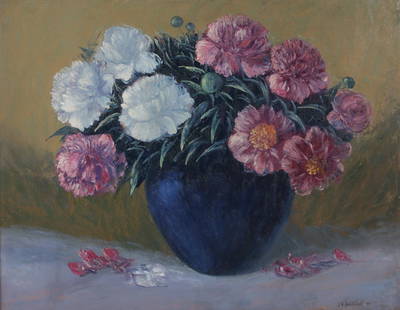
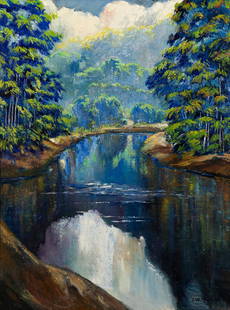
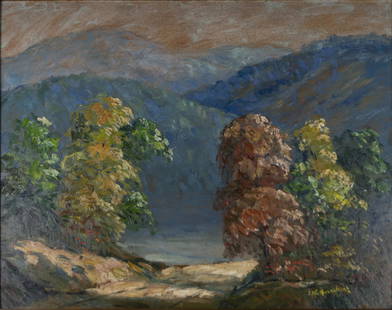
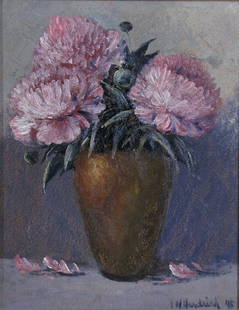
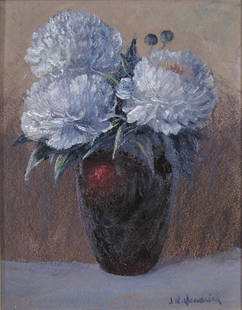
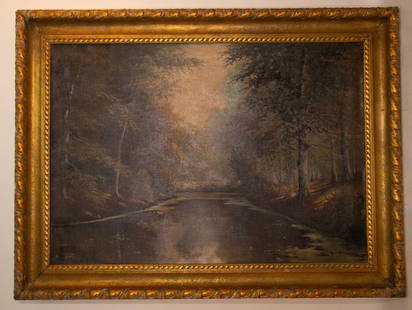
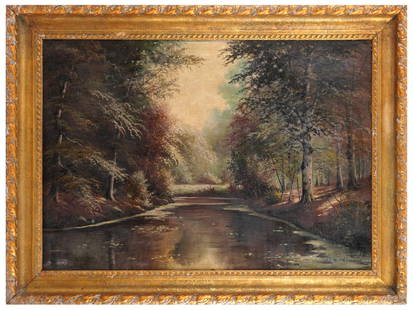
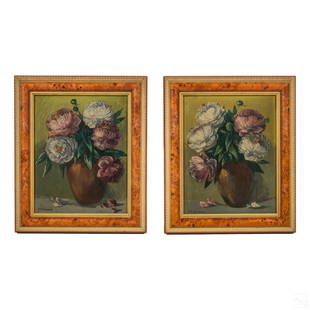

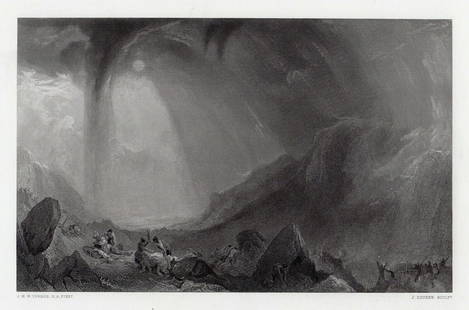


































![[SEX] LOT OF 9 PHOTOGRAPHS SOLD TOGETHER: [SEX] A lot of 9 photographs sold together. Some postcards. One mounted with plastic corners in archival mat. Prints: 4.5" x 3" - 6" x 4". Generally good condition, various imperfections. *Additional](https://p1.liveauctioneers.com/8124/329546/177689790_1_x.jpg?height=310&quality=70&version=1715469494)



